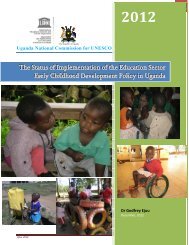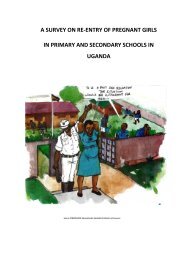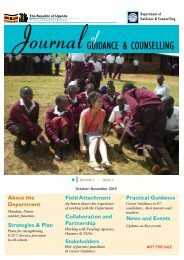Download Pdf - Ministry of Education and Sports
Download Pdf - Ministry of Education and Sports
Download Pdf - Ministry of Education and Sports
Create successful ePaper yourself
Turn your PDF publications into a flip-book with our unique Google optimized e-Paper software.
Out <strong>of</strong> 1,712,420 (male 859,343; female 853,077) pupils who started P.1 in 2005, 60 % (male 61.8%; female<br />
60.9%) successively reached grade five in 2009 as compared to 53.3% in 2008. In 2012, the survival rate<br />
was 59% (male 58%; female 60%). Results show that more females successfully survived to grade five<br />
as compared to males. However, the target <strong>of</strong> 100 percent survival rate to grade five is not likely to be<br />
met by 2015 given the current gap <strong>of</strong> 41 percent (male 42%; female 40%).<br />
Primary Seven Completion Rates<br />
98<br />
The completion rate influences a country’s level <strong>of</strong> literacy <strong>and</strong> numeracy as well as the level <strong>of</strong><br />
development <strong>of</strong> the education system. Completion rates for primary education remain below the<br />
desired target <strong>of</strong> 100 percent. Figure 4.30 below shows Ug<strong>and</strong>a’s Primary Completion rate for the last<br />
eleven years;<br />
Figure 4.30: Primary Seven Completion Rates<br />
120%<br />
100%<br />
P.7 Completion Rate<br />
80%<br />
60%<br />
40%<br />
20%<br />
0%<br />
2002 2003 2004 2005 2006 2007 2008 2009 2010 2011 2012 2015*<br />
Total 49% 56% 54% 51% 48% 47% 49% 52% 54% 64% 67% 100%<br />
Male 59% 66% 60% 54% 55% 50% 51% 55% 56% 65% 68% 100%<br />
Female 41% 47% 47% 47% 42% 44% 47% 48% 51% 63% 66% 100%<br />
Source: EMIS 20022012<br />
Ug<strong>and</strong>a’s primary completion rates stagnated between 2006 <strong>and</strong> 2008. In 2009, only 52% <strong>of</strong> the<br />
children completed primary seven. Since then, the completion rate has been improving steadily. In<br />
2012, the completion rate improved by 3%age points from 64% in 2011 to 67% (68% male; 66% female)<br />
in 2012.<br />
Based on studies conducted in Ug<strong>and</strong>a <strong>and</strong> else were in the world, enhancement <strong>of</strong> financial support<br />
to ECD would result into improved completion rate <strong>and</strong> perhaps meeting the desired 100 percent<br />
target by 2019.<br />
4.4.1.2 Status <strong>and</strong> trends for Goal 3<br />
Goal 3 targets at the elimination <strong>of</strong> all gender disparities at primary <strong>and</strong> secondary education levels by<br />
2005, <strong>and</strong> in all levels <strong>of</strong> education no later than 2015. Progress made towards promotion <strong>of</strong> gender<br />
equality <strong>and</strong> empower women is tracked through five indicators <strong>and</strong> these include;ratio <strong>of</strong> girls to<br />
boys at all levels <strong>of</strong> education, ratio <strong>of</strong> literate women to men (524 years old), share <strong>of</strong> women in wage<br />
employment in the nonagriculture sector <strong>and</strong>proportion <strong>of</strong> seats held by women in national<br />
parliament 2 .<br />
Year<br />
2 A total <strong>of</strong> 302 members constitute Ug<strong>and</strong>a’s 8 th Parliament out <strong>of</strong> which 104 (31.8%) were female.<br />
ESSAPR FY 2011/12 to inform the 19 th ESSR – OCTOBER 2012








